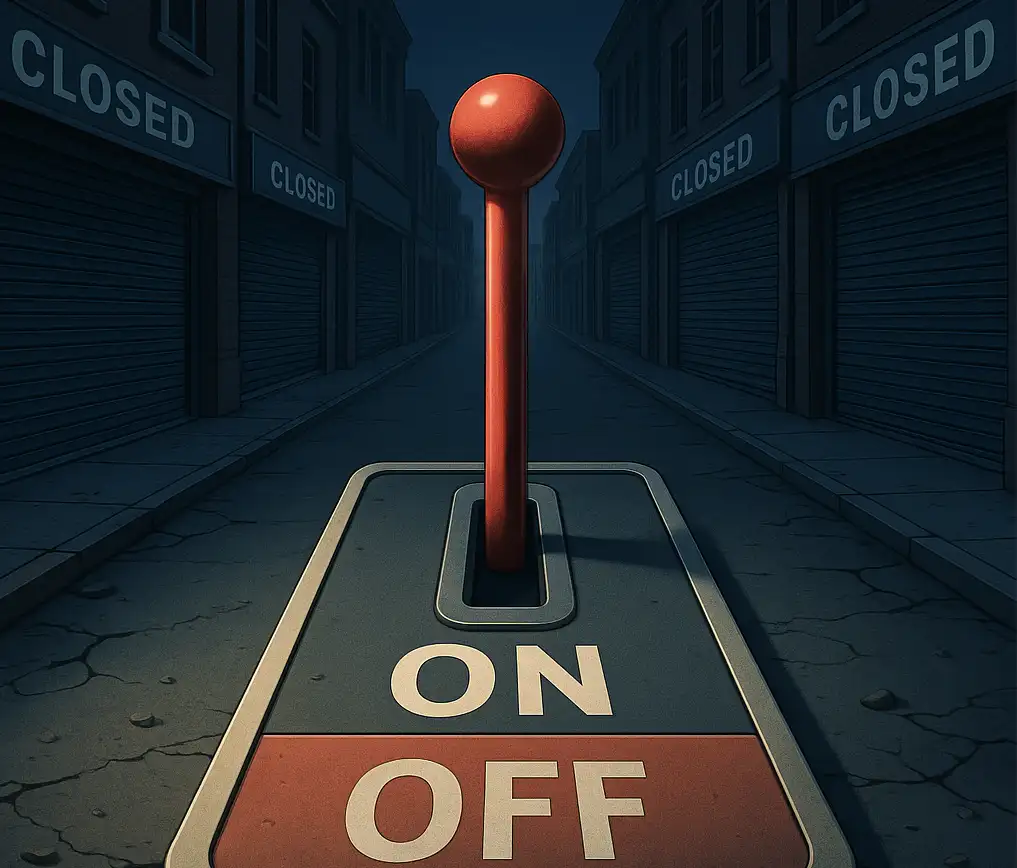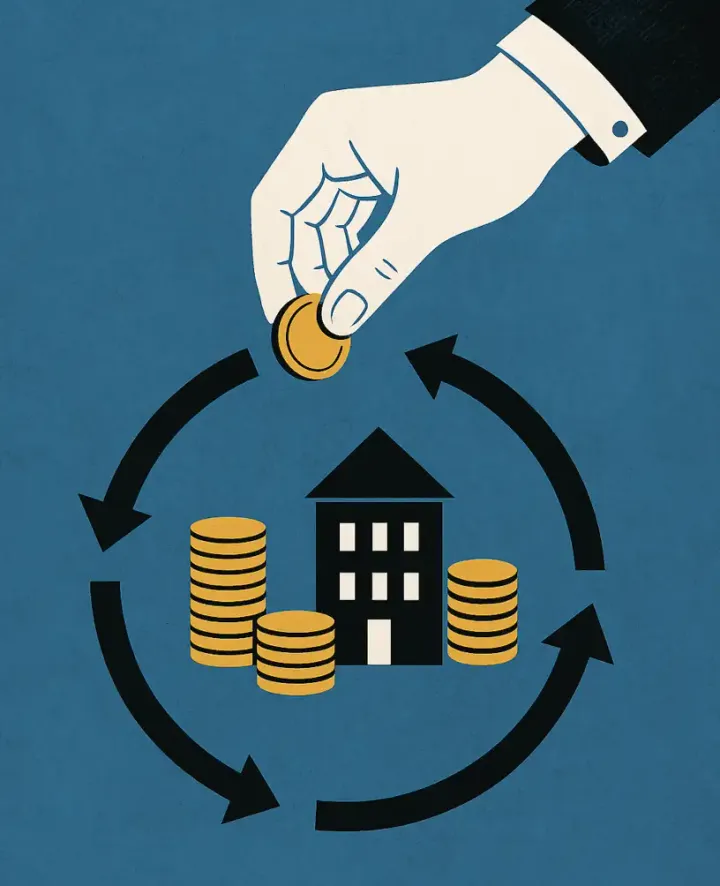The Quiet Death of Korea’s Local Economies
Korea’s self-employed are disappearing — not from laziness or lack of innovation, but from operating in a system designed to make survival improbable. Without bold structural reform, small businesses will remain the shock absorbers of economic failure, not beneficiaries of national growth.

“It’s not about profits anymore. Survival is the goal.”
That’s how one former café owner in Daejeon, South Korea, described the reality of running a small business in 2025. Her shop, once seen as a dream fulfilled after years of saving and government-backed startup programs, closed within six months. The rent was too high, foot traffic too low, and delivery app fees too punishing.
Her story is not an outlier. Across South Korea, from urban alleys to rural markets, a once-vibrant self-employment ecosystem is unraveling. As major cities sprawl and smaller towns hollow out, local economies dependent on restaurants, cafés, convenience stores, and other microenterprises are deteriorating under pressure.
While many nations grapple with economic turbulence, South Korea faces a uniquely structural breakdown: a crisis of self-employment — intensified by digital monopolies, unchecked franchise models, and years of unregulated urban expansion. Yet, despite growing evidence of systemic failure, public policy remains fragmented, reactive, and largely cosmetic.
The Slow Collapse of Regional Commerce
For decades, self-employment has been a cornerstone of South Korea’s economy, accounting for nearly a quarter of total employment — one of the highest rates in the OECD. But behind that statistic lies a deteriorating reality. In 2025, the country’s small business ecosystem is shrinking at a pace unseen in modern times, especially in non-metropolitan regions.
Recent data from Seoul’s commercial analytics division shows that in the first quarter of 2025, the number of newly opened businesses in the capital fell by more than 50% compared to two years prior. Meanwhile, closures outnumbered openings by a ratio of 1.7 to 1 — a reversal of the post-pandemic recovery narrative.
Outside of Seoul, the picture is even more troubling. Over half of Korea’s 228 municipal areas are officially classified as “population extinction zones,” with youth migration, aging populations, and declining birth rates accelerating local economic collapse. In these regions, the closure of a single convenience store or restaurant is often the beginning of a wider unraveling — fewer services, fewer jobs, and fewer reasons to stay.
Small businesses in Korea are not just economic units — they are vital threads in the social fabric. When they disappear, entire communities fade with them. And today, that disappearance is not occasional or random. It is systemic.
Platform Capitalism – The Digital Middleman Trap
Once seen as a lifeline for small businesses during the COVID-19 pandemic, Korea’s food delivery platforms have now become an inescapable cost center for many local merchants. Apps such as Baemin, Yogiyo, and Coupang Eats dominate not only the logistics chain but also marketing, discovery, and payment infrastructure — leaving business owners with little choice but to participate, even at a loss.
Restaurants and cafes often pay between 15% and 30% of each transaction to these platforms, through a complex mix of commission, promotion, and service fees. To gain visibility, merchants must compete in bidding-based ad auctions, sometimes spending hundreds of dollars a month simply to appear in search results.
In effect, small businesses are forced to lease their digital presence from a handful of private companies. While platform operators benefit from network effects and data monopolies, local merchants surrender control over pricing, branding, and customer relationships. The economic result is familiar: platform revenue rises while merchant margins thin to unsustainable levels.
Yet this is not just a financial squeeze — it’s a structural shift in market power. Small businesses have been repositioned not as entrepreneurs, but as subordinate nodes in a vertically integrated digital supply chain. In regions with low foot traffic and limited marketing alternatives, this dependence borders on digital serfdom.
Franchise Capitalism – The Illusion of Ownership
To many aspiring entrepreneurs in South Korea, a franchise offers the promise of a safer path into business — a recognized brand, proven concept, and standardized operations. But behind the glossy brochures and training seminars lies a sobering reality: the franchise model often offloads financial risk to individual shop owners, while retaining profit and control at the corporate level.
Franchisees typically pay substantial up-front costs — including brand licensing fees, construction contracts, and mandatory equipment or interior design sourced directly from the headquarters. Even after launch, they are tied to exclusive suppliers (usually owned by the franchisor), fixed pricing policies, and rigid marketing mandates.
Worse still, South Korean franchise laws offer little protection against predatory expansion. It’s not uncommon for the same franchise to authorize multiple outlets within a few hundred meters of one another, pitting their own franchisees against each other in zero-sum competition. In some cases, new locations open just months after an initial store’s debut — with no recourse for the original investor.
For many franchisees, the result is unsustainable debt, followed by closure — sometimes within a year. Yet while individual shop owners lose their capital and credit ratings, the franchisor continues to profit from initial fees, product sales, and new contracts elsewhere. It’s a model designed not for long-term local success, but for rapid brand expansion and short-cycle monetization.
The illusion of ownership — that one is “running their own business” — masks a deeper imbalance of power and accountability. In reality, many franchisees are little more than contract-bound operators in a vertically controlled ecosystem.
Urban Oversupply – The Architecture of Failure
Beneath the economic woes of Korea’s self-employed lies a silent accomplice: the country’s urban design model. For years, real estate-led growth has driven local governments to approve massive commercial developments tied to residential complexes — often without any demand analysis or tenant planning. The result: cities saturated with storefronts but starved of customers.
In new apartment blocks, ground-floor retail spaces are marketed and sold to investors long before a single business opens. These units, often priced for speculative gain, remain vacant or quickly rotate through tenants — most of whom operate in highly competitive categories such as cafés, bakeries, or beauty salons. Oversupply leads to internal cannibalization, even in newly built areas.
This issue is not limited to the suburbs. In older city centers, traditional commercial streets are experiencing simultaneous decay and crowding. Some areas have too many shops chasing too few consumers; others are filled with hollowed-out rows of shuttered stores. Either way, the urban fabric becomes fragmented, unstable, and unattractive for both businesses and residents.
Crucially, there is little coordination between commercial zoning, small business support, and demographic forecasting. Instead, land is treated as a revenue source — and retail spaces as commodities to be sold, not curated. Local authorities often depend on real estate development fees to fund budgets, incentivizing quantity over sustainability.
The outcome is predictable: collapsing rent yields, increased default rates, and communities stripped of their commercial lifeblood. In the worst cases, once-vibrant neighborhoods become "storefront deserts" — populated not by people, but by unlit signs and locked roller shutters.
Policy Failures – Cosmetic Solutions in a Structural Crisis
Despite mounting evidence of collapse across Korea’s self-employment sector, policy responses remain fragmented, reactive, and often symbolic. From startup subsidies to emergency loans, government programs have proliferated — but few address the structural forces that drive repeated business failure.
During the COVID-19 pandemic, direct cash support and debt deferrals helped many businesses stay afloat temporarily. But post-pandemic, the government’s pivot to revitalization has leaned heavily on “youth entrepreneurship” as a catch-all solution. Under various national and municipal schemes, young people are encouraged — even incentivized — to open small businesses, often in saturated markets, with minimal consumer demand.
These programs overlook a critical reality: survival rates for new businesses remain dismal. National data shows that more than half of self-employed ventures close within three years, and only one in three survive beyond five. In effect, policy has shifted the burden of economic development onto inexperienced individuals, while offering little in the way of support for long-term sustainability or failure recovery.
Moreover, most self-employed Koreans remain excluded from meaningful social protections. Many are ineligible for unemployment insurance, and very few receive assistance when closing down. Programs like the “Hope Return Package” offer some financial counseling or minor grants for business closure — but with demand for such services increasing by over 60% in just one year, it is clear the scale of intervention is far below what’s required.
Critically, there has been no coordinated response to platform overreach, franchise regulation, or urban oversupply. Each problem is treated in isolation — if at all — and economic ministries rarely coordinate with local governments, who are more focused on construction revenues than commercial viability.
In the absence of systemic reform, Korea’s self-employed are being managed, not empowered. And for many, the help arrives too late — or not at all.
Why Korea Must Rethink Its Small Business Economy
In a country where self-employment was once synonymous with resilience and social mobility, South Korea’s small business sector now stands as a symbol of systemic neglect. Years of platform consolidation, unchecked franchise expansion, and overbuilt commercial districts have not just weakened individual entrepreneurs — they have corroded the infrastructure of local economies.
Yet government responses remain anchored in outdated assumptions. The state continues to promote entrepreneurship as a solution to youth unemployment, while offering little structural support to those who fail. A growing number of merchants operate in markets designed to extract, not sustain — locked into supply chains and digital platforms that favor the top of the pyramid.
Experts warn that without deep institutional reform, the self-employed will remain economic shock absorbers rather than beneficiaries of growth. Rebalancing this ecosystem will require coordinated regulation — not only of delivery platforms and franchise contracts, but also of how cities are physically built around commerce. It also means offering the self-employed the same social protections afforded to full-time workers: insurance against failure, access to retraining, and a dignified way to exit the market when survival becomes impossible.
Korea is not alone in confronting these questions. But with one of the world’s highest self-employment rates, its failure to act carries unique consequences. Every shuttered shopfront in a small town, every empty stall in a neighborhood market, signals more than personal misfortune — it signals a missed opportunity to protect the foundations of community life.
If the next administration is serious about rebuilding national resilience, it must recognize that the crisis of self-employment is no longer a fringe issue. It is a frontline test of economic justice — and the outcome will define whether local economies in Korea continue to fade, or finally begin to heal.



Comments ()